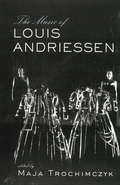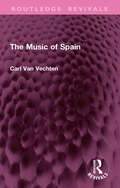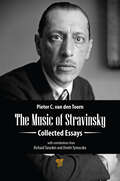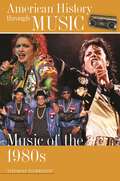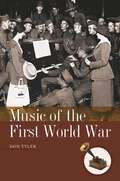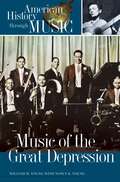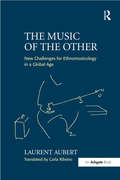- Table View
- List View
Music of Louis Andriessen
by Maja TrochimczykThis book presents the musician in dialog with a Polish-Canadian musicologist and three of his Dutch friends and collaborators, Reinbert de Leeuw, Elmer Schönberger and Frits van der Waa. Topics include his artistic evolution, his relationship to minimalism, his prevalent interest in mysticism and meaning, the use of quotation and writing for
The Music of Malaysia: The Classical, Folk and Syncretic Traditions (SOAS Studies in Music Series)
by Patricia Matusky Tan Sooi BengThe Music of Malaysia, first published in Malay in 1997 and followed by an English edition in 2004 is still the only history, appreciation and analysis of Malaysian music in its many and varied forms available in English. The book categorizes the types of music genres found in Malaysian society and provides an overview of the development of music in that country. Analyses of the music are illustrated with many examples transcribed from original field recordings. Genres discussed include theatrical and dance forms, percussion ensembles, vocal and instrumental music and classical music. It is an excellent introduction to and exploration of the country's vibrant musical culture. This new, fully revised and updated edition includes time lines, listening guides and two audio CDs of field recordings that are analysed and discussed in the text.
The Music of Malaysia: The Classical, Folk and Syncretic Traditions (SOAS Studies in Music Series)
by Patricia Matusky Tan Sooi BengThe Music of Malaysia, first published in Malay in 1997 and followed by an English edition in 2004 is still the only history, appreciation and analysis of Malaysian music in its many and varied forms available in English. The book categorizes the types of music genres found in Malaysian society and provides an overview of the development of music in that country. Analyses of the music are illustrated with many examples transcribed from original field recordings. Genres discussed include theatrical and dance forms, percussion ensembles, vocal and instrumental music and classical music. It is an excellent introduction to and exploration of the country's vibrant musical culture. This new, fully revised and updated edition includes time lines, listening guides and two audio CDs of field recordings that are analysed and discussed in the text.
The Music of Michael Nyman: Texts, Contexts and Intertexts
by Pwyll ap SiônNyman's rise to international prominence during the last three decades has made him one of the world's most successful living composers. His music has nevertheless been criticized for its parasitic borrowing of other composers' ideas and for its relentless self-borrowing. In this first book-length study in English, Pwyll ap Si laces Nyman's writings within the general context of Anglo-American experimentalism, minimalism and post-minimalism, and provides a series of useful contexts from which controversial aspects of Nyman's musical language can be more clearly understood and appreciated. Drawing upon terms informed by intertextual theory in general, appropriation and borrowing are first introduced within the context of twentieth-century art music and theory. Intertextual concepts are explained and their terms defined before Nyman's musical language is considered in relation to a series of intertextual classifications and types. These types then form the basis of a more in-depth study of his works during the second half of the book, ranging from opera and chamber music to film. Rather than restricting style and technique, Nyman's intertextual approach, on the contrary, is shown to provide his music with an almost infinite amount of variety, flexibility and diversity, and this has been used to illustrate a wide range of technical, aesthetic and expressive forms. He composes with his ear towards the past as if it were a rich quarry to mine, working like a musical archaeologist, uncovering artefacts and chiselling fresh and vibrant sonic edifices out of them.
The Music of Michael Nyman: Texts, Contexts and Intertexts
by Pwyll ap SiônNyman's rise to international prominence during the last three decades has made him one of the world's most successful living composers. His music has nevertheless been criticized for its parasitic borrowing of other composers' ideas and for its relentless self-borrowing. In this first book-length study in English, Pwyll ap Si laces Nyman's writings within the general context of Anglo-American experimentalism, minimalism and post-minimalism, and provides a series of useful contexts from which controversial aspects of Nyman's musical language can be more clearly understood and appreciated. Drawing upon terms informed by intertextual theory in general, appropriation and borrowing are first introduced within the context of twentieth-century art music and theory. Intertextual concepts are explained and their terms defined before Nyman's musical language is considered in relation to a series of intertextual classifications and types. These types then form the basis of a more in-depth study of his works during the second half of the book, ranging from opera and chamber music to film. Rather than restricting style and technique, Nyman's intertextual approach, on the contrary, is shown to provide his music with an almost infinite amount of variety, flexibility and diversity, and this has been used to illustrate a wide range of technical, aesthetic and expressive forms. He composes with his ear towards the past as if it were a rich quarry to mine, working like a musical archaeologist, uncovering artefacts and chiselling fresh and vibrant sonic edifices out of them.
The Music of Mzilikazi Khumalo: Language, Culture, and Song in South Africa
by Thomas M. Pooley, Naomi André, Innocentia Mhlambi, and Donato SommaMzilikazi Khumalo (1932-2021), an iconic figure in choral music in South Africa, rose to prominence as one of Africa's leading composers of art music. This is a work of music history.Biographical essays on Khumalo's major works, including those for choir, orchestra, and opera are complemented by contextual studies of his compositions and arrangements as well as reflections on his roles as editor, conductor, and music director. Specifically in the context of South Africa's cultural and political transition from Apartheid to democracy, Khumalo's key role in establishing the Nation Building Massed Choir Festival, a multi-racial institution that forged an inclusive space for music, in the 1980s is discussed as evidence of his importance and relevance in South African culture.Khumalo's major works are studied in relation to contemporary art music, choral composition, and traditional song. These are UShaka KaSenzangakhona (1996), an African epic, and Princess Magogo KaDinuzulu (2002), one of the first indigenous African operas. Khumalo's artistic collaborators provide insight into their experiences working on these major projects, documenting the relationships the composer cultivated with his peers. This volume addresses a lacuna in the literature on South African art music which until recently tended to focus on works in the classical tradition and shows that Khumalo is a composer without peer in his synthesis of classical and choral, traditional and contemporary.
The Music of Mzilikazi Khumalo: Language, Culture, and Song in South Africa
Mzilikazi Khumalo (1932-2021), an iconic figure in choral music in South Africa, rose to prominence as one of Africa's leading composers of art music. This is a work of music history.Biographical essays on Khumalo's major works, including those for choir, orchestra, and opera are complemented by contextual studies of his compositions and arrangements as well as reflections on his roles as editor, conductor, and music director. Specifically in the context of South Africa's cultural and political transition from Apartheid to democracy, Khumalo's key role in establishing the Nation Building Massed Choir Festival, a multi-racial institution that forged an inclusive space for music, in the 1980s is discussed as evidence of his importance and relevance in South African culture.Khumalo's major works are studied in relation to contemporary art music, choral composition, and traditional song. These are UShaka KaSenzangakhona (1996), an African epic, and Princess Magogo KaDinuzulu (2002), one of the first indigenous African operas. Khumalo's artistic collaborators provide insight into their experiences working on these major projects, documenting the relationships the composer cultivated with his peers. This volume addresses a lacuna in the literature on South African art music which until recently tended to focus on works in the classical tradition and shows that Khumalo is a composer without peer in his synthesis of classical and choral, traditional and contemporary.
The Music of Physics: An Introduction to the Harmonies of Nature
by George N. GibsonThis textbook is written for a very specific purpose and audience: It serves as a breadth requirement for a general education program at the college level for non-science majors. It is also suitable for an introductory course at the high school level. Music is an excellent medium to introduce physics to novice scientists, as it provides an intuitive understanding of the physics of waves. While there are no mathematical derivations in the text, labs are provided to verify every concept and equation. The book is not restricted to purely musical topics. Each topic is carefully chosen to relate to broader principles applicable to other areas of physics or technology. This is not meant to be a highly technical treatise on sound and musical instruments. Rather, it shows deep connections between waves and many areas of modern physics to make the text engaging and relevant to the students.
The Music of Physics: An Introduction to the Harmonies of Nature
by George N. GibsonThis textbook is written for a very specific purpose and audience: It serves as a breadth requirement for a general education program at the college level for non-science majors. It is also suitable for an introductory course at the high school level. Music is an excellent medium to introduce physics to novice scientists, as it provides an intuitive understanding of the physics of waves. While there are no mathematical derivations in the text, labs are provided to verify every concept and equation. The book is not restricted to purely musical topics. Each topic is carefully chosen to relate to broader principles applicable to other areas of physics or technology. This is not meant to be a highly technical treatise on sound and musical instruments. Rather, it shows deep connections between waves and many areas of modern physics to make the text engaging and relevant to the students.
The Music of Sounds and the Music of Things: Sonic Creativity Within Sampling and DIY Cultures
by Leigh Landy John RichardsThis book investigates two areas in which the appreciation of sonic creativity can be easily acquired across diverse cultures, ages and interests: the music of sounds – making music with any sounds, part of today’s sampling culture and the music of things – and the creation of instruments using existent materials (another type of sampling?) involving the notion of ‘instrument as composition’ as part of today’s DIY (or DIT, do it together) culture.The book offers broad discussions regarding the music of things (written by John Richards) followed by the music of sounds (written by Leigh Landy). These chapters are followed by a focus on the workshop demonstrating the collaborative and inclusive potential in both areas, and a spotlight on eight artists with a broad diversity of backgrounds and approaches to sound and music who discuss their perceptions. The book’s conclusion focuses on similarities and differences between the music of sounds and the music of things, suggesting, finally, that both might form part of the 21st- century’s folk music landscape.The book is primarily aimed towards students interested in current forms of sonic creativity but will be of interest to those interested in broader issues of sampling culture, hacking and sound studies.
The Music of Sounds and the Music of Things: Sonic Creativity Within Sampling and DIY Cultures
by Leigh Landy John RichardsThis book investigates two areas in which the appreciation of sonic creativity can be easily acquired across diverse cultures, ages and interests: the music of sounds – making music with any sounds, part of today’s sampling culture and the music of things – and the creation of instruments using existent materials (another type of sampling?) involving the notion of ‘instrument as composition’ as part of today’s DIY (or DIT, do it together) culture.The book offers broad discussions regarding the music of things (written by John Richards) followed by the music of sounds (written by Leigh Landy). These chapters are followed by a focus on the workshop demonstrating the collaborative and inclusive potential in both areas, and a spotlight on eight artists with a broad diversity of backgrounds and approaches to sound and music who discuss their perceptions. The book’s conclusion focuses on similarities and differences between the music of sounds and the music of things, suggesting, finally, that both might form part of the 21st- century’s folk music landscape.The book is primarily aimed towards students interested in current forms of sonic creativity but will be of interest to those interested in broader issues of sampling culture, hacking and sound studies.
The Music of Spain (Routledge Revivals)
by Carl Van VechtenFirst published in 1920, The Music of Spain deals with historical periods, schools and style and appears to embrace everything related to music provided it affects or is affected by Spain in some degree, no matter how small or insignificant. The period extends from the sixteenth century to the early twentieth century and the author encircles his subject in a huge ring or parenthesis that opens with Antonio Cabezon, the Spanish Bach (according to Pedrell) and closes with the gypsy dancer and singer Pastora Imperio, queen of the Spanish “varieties” stage of today. It brings themes like Spain and music; the land of joy; and from George Borrow to Mary Garden. This book is an important historical reference for students and scholars of history of music, Spanish music.
The Music of Spain (Routledge Revivals)
by Carl Van VechtenFirst published in 1920, The Music of Spain deals with historical periods, schools and style and appears to embrace everything related to music provided it affects or is affected by Spain in some degree, no matter how small or insignificant. The period extends from the sixteenth century to the early twentieth century and the author encircles his subject in a huge ring or parenthesis that opens with Antonio Cabezon, the Spanish Bach (according to Pedrell) and closes with the gypsy dancer and singer Pastora Imperio, queen of the Spanish “varieties” stage of today. It brings themes like Spain and music; the land of joy; and from George Borrow to Mary Garden. This book is an important historical reference for students and scholars of history of music, Spanish music.
The Music of Stravinsky: Collected Essays
by Pieter C. van den ToornThe most celebrated of Western composers in the twentieth century, Igor Stravinskymay have been the greatest as well. Stretching across forty or so years, the essays in this volume address the dynamics of Igor Stravinsky’s music from a variety of analytical, critical, and aesthetic angles. Underscored are the features of melody, harmony, rhythm, and form that would remain consistently a part of Stravinsky’s oeuvre regardless of the changes in orientation from the Russian period to the neoclassical and the early serial. The Rite of Spring (1913), Les Noces (1917–23), the Symphony of Psalms (1930), and the Symphony in Three Movements (1945) are discussed in detail, as are many of the circumstances attending their conception. Other concerns include the composer’s "formalist" aesthetics and the strict performing style he pursued as an interpreter and conductor of his music.
The Music of Stravinsky: Collected Essays (Music Since 1900 Ser.)
by Pieter C. van den ToornThe most celebrated of Western composers in the twentieth century, Igor Stravinskymay have been the greatest as well. Stretching across forty or so years, the essays in this volume address the dynamics of Igor Stravinsky’s music from a variety of analytical, critical, and aesthetic angles. Underscored are the features of melody, harmony, rhythm, and form that would remain consistently a part of Stravinsky’s oeuvre regardless of the changes in orientation from the Russian period to the neoclassical and the early serial. The Rite of Spring (1913), Les Noces (1917–23), the Symphony of Psalms (1930), and the Symphony in Three Movements (1945) are discussed in detail, as are many of the circumstances attending their conception. Other concerns include the composer’s "formalist" aesthetics and the strict performing style he pursued as an interpreter and conductor of his music.
Music of the 1980s (American History through Music)
by Thomas HarrisonBeyond coverage of mainstream 80s music, such as "hair band" hard rock, pop, new wave, and rap, this compilation of essential musical artists also covers genres like classical, jazz, outlaw country, and music theater.Popular music in the United States during the 1980s is well known for imports from abroad, such as A-ha, Def Leppard, Falco, and Men at Work, as well as homegrown American rock acts such as Guns 'N Roses, Huey Lewis and the News, Bon Jovi, and Poison. But there were many other types of genres of music that never received airplay on the radio or MTV that also experienced significant evolutions or growth in that decade.Music of the 1980s examines the key artists in specific genres of popular music: pop, hard rock/heavy metal, rock, and country. No other reference book for students has previously explored the surprisingly diverse categories of hard rock and heavy metal music with such detail and depth. Additionally, a chapter focuses on the prominent artists and composers of less-mainstream genres for specialized audiences, including music theater, jazz, and classical music.
Music of the 1990s (American History through Music)
by Thomas HarrisonRed Hot Chili Peppers, Goo Goo Dolls, Nirvana, Green Day, Mariah Carey, Notorious B.I.G., Billy Ray Cyrus, Backstreet Boys… the list goes on. Meet all the 1990s' essential musical artists in one insightful volume.During the 1990s, musical genres became more commercialized than ever—and that was just one of the many changes that characterized the decade. Music of the 1990s offers a detailed and wide-ranging view of the important music of the '90s, identifying the artists and the important compositions—popular, classical, and jazz—that helped shape the period. The book focuses on key artists in specific genres in popular music, including pop, hard rock/heavy metal, rock, and country. Specialized genres are examined as well, in a chapter that discusses prominent artists and composers in musical theater, jazz, popular Christian music, and classical music.Among other topics, the book looks at the growth of urban-based rap and other popular music in the context of the rise of music television. Hard rock and heavy metal are also examined within the music video idiom. New trends in mainstream rock and country music are explored as well.
Music of the First World War (American History through Music)
by Don TylerThis book discusses WWI-era music in a historical context, explaining music's importance at home and abroad during WWI as well as examining what music was being sung, played, and danced to during the years prior to America's involvement in the Great War.Why was music so important to soldiers abroad during World War I? What role did music—ranging from classical to theater music, rags, and early jazz—play on the American homefront? Music of the First World War explores the tremendous importance of music during the years of the Great War—when communication technologies were extremely limited and music often took the place of connecting directly with loved ones or reminiscing via recorded images.The book's chapters cover music's contribution to the war effort; the variety of war-related songs, popular hits, and top recording artists of the war years; the music of Broadway shows and other theater productions; and important composers and lyricists. The author also explores the development of the fledgling recording industry at this time.
Music of the First World War (American History through Music)
by Don TylerThis book discusses WWI-era music in a historical context, explaining music's importance at home and abroad during WWI as well as examining what music was being sung, played, and danced to during the years prior to America's involvement in the Great War.Why was music so important to soldiers abroad during World War I? What role did music—ranging from classical to theater music, rags, and early jazz—play on the American homefront? Music of the First World War explores the tremendous importance of music during the years of the Great War—when communication technologies were extremely limited and music often took the place of connecting directly with loved ones or reminiscing via recorded images.The book's chapters cover music's contribution to the war effort; the variety of war-related songs, popular hits, and top recording artists of the war years; the music of Broadway shows and other theater productions; and important composers and lyricists. The author also explores the development of the fledgling recording industry at this time.
The Music of the Future: Sound and Vision in the Caribbean (Critical Conjunctures in Music and Sound)
by Martin MunroIn this book, author Martin Munro offers a new path into Caribbean studies based on sound. He argues that to understand and begin to transform the past, present, and future of Caribbean studies, historians must do so at the node of both sound and vision. The book makes a compelling case for a broad realignment of Caribbean studies with particular emphasis on the sonic dimensions of Caribbean art, literature, travel writing, history, and society. From there, the book illustrates how sound and vision are closely connected in the Caribbean, to the point where they almost fuse into another, hybrid sense in which might be found the knotty truths and realities of the region, its people, and its relations with others. Munro creates a mode of analyzing and understanding the multiple dialogues between visuality and aurality in relation to race, art, tourism, media, and literature. Crossing national and linguistic borders, he presents the Caribbean as a region and, working across media, he offers an expansive exploration of visuality and sound. The book's primary materials are varied--poems, novels, travel writing, amateur films, tourist movies, music, visual art--but united by the presence of the European-Caribbean, sound-vision dynamic that shapes so many accounts of cultural encounter in the region. The book traces this dynamic across the materials to give a sense of how it reappears in different times and places to become a defining element of European-Caribbean cultural and social relations and of how and why sound in its myriad manifestations becomes such a prevalent marker of Caribbean being, culture, and society.
The Music of the Future: Sound and Vision in the Caribbean (Critical Conjunctures in Music and Sound)
by Martin MunroIn this book, author Martin Munro offers a new path into Caribbean studies based on sound. He argues that to understand and begin to transform the past, present, and future of Caribbean studies, historians must do so at the node of both sound and vision. The book makes a compelling case for a broad realignment of Caribbean studies with particular emphasis on the sonic dimensions of Caribbean art, literature, travel writing, history, and society. From there, the book illustrates how sound and vision are closely connected in the Caribbean, to the point where they almost fuse into another, hybrid sense in which might be found the knotty truths and realities of the region, its people, and its relations with others. Munro creates a mode of analyzing and understanding the multiple dialogues between visuality and aurality in relation to race, art, tourism, media, and literature. Crossing national and linguistic borders, he presents the Caribbean as a region and, working across media, he offers an expansive exploration of visuality and sound. The book's primary materials are varied--poems, novels, travel writing, amateur films, tourist movies, music, visual art--but united by the presence of the European-Caribbean, sound-vision dynamic that shapes so many accounts of cultural encounter in the region. The book traces this dynamic across the materials to give a sense of how it reappears in different times and places to become a defining element of European-Caribbean cultural and social relations and of how and why sound in its myriad manifestations becomes such a prevalent marker of Caribbean being, culture, and society.
Music of the Gilded Age (American History through Music)
by N. Lee OrrAmerica's Gilded Age was a time of great musical evolution. As the country continued to develop a musical style apart from Europe, its church and religious music and opera took on new forms. Music-as-entertainment also evolved, with marching bands at public events and the new musicals in theaters. This volume presents the composers, musicians, songwriters, instruments and musical forms that uniquely identify the Gilded Age.Chapters include: Concerts and Symphony orchestras; Grand Opera; Composers, Critics, and Conservatories; Amateurs and Music at Home; Sacred Music, Black and White; Ragtime, Vaudeville, and the American Musical Stage; Music, Politics, and the Progressive Movement; and Music Industries and Technology
Music of the Great Depression (American History through Music)
by William H. Young Nancy K. YoungPrior to the stock market crash of 1929 American music still possessed a distinct tendency towards elitism, as songwriters and composers sought to avoid the mass appeal that critics scorned. During the Depression, however, radio came to dominate the other musical media of the time, and a new era of truly popular music was born. Under the guidance of the great Duke Ellington and a number of other talented and charismatic performers, swing music unified the public consciousness like no other musical form before or since. At the same time the enduring legacies of Woody Guthrie in folk, Aaron Copeland in classical, and George and Ira Gershwin on Broadway stand as a testament to the great diversity of tastes and interests that subsisted throughout the Great Depression, and play a part still in our lives today. The lives of these and many other great musicians come alive in this insightful study of the works, artists, and circumstances that contributed to making and performing the music that helped America through one of its most difficult times.The American History through Music series examines the many different styles of music that have played a significant part in our nation's history. While volumes in this series show the multifaceted roles of music in our culture, they also use music as a lens through which readers may study American social history. The authors present in-depth analysis of American musical genres, significant musicians, technological innovations, and the many connections between music and the realms of art, politics, and daily life.
The Music of the Other: New Challenges for Ethnomusicology in a Global Age
by Laurent AubertWe are surrounded by new musical encounters today as never before, and the experience of musics from elsewhere is progressively affecting all arenas of the human conscience. Yet why is it that Western listeners expect a certain cultural and ethnic 'authenticity' or 'otherness' from visiting artists in world music, while contemporary musicians in Western music are no longer bound by such restraints? Should we feel uncomfortable when sacred rites from Asia or Africa are remade for Westerners as musical entertainment? As these thorny questions suggest, the great flood of world musics and of their agents into our most immediate cultural environment is not a simple matter of expanding global musical exchange. Instead, complex processes are at work involving the growth of intercontinental tourism, the development of new technologies of communication and our perceptions both of ourselves and of the new musical others now around us. Elegantly tracing the dimensions of these new musical encounters, Laurent Aubert considers the impact of world musics on our values, our habits and our cultural practices. His discussions of key questions about our contemporary music culture widen conventional ethnomusicological perspectives to consider not only the nature of Western society as a 'global village' but also the impact of current Western demands on the future of world musics and their practitioners.
The Music of the Other: New Challenges for Ethnomusicology in a Global Age
by Laurent AubertWe are surrounded by new musical encounters today as never before, and the experience of musics from elsewhere is progressively affecting all arenas of the human conscience. Yet why is it that Western listeners expect a certain cultural and ethnic 'authenticity' or 'otherness' from visiting artists in world music, while contemporary musicians in Western music are no longer bound by such restraints? Should we feel uncomfortable when sacred rites from Asia or Africa are remade for Westerners as musical entertainment? As these thorny questions suggest, the great flood of world musics and of their agents into our most immediate cultural environment is not a simple matter of expanding global musical exchange. Instead, complex processes are at work involving the growth of intercontinental tourism, the development of new technologies of communication and our perceptions both of ourselves and of the new musical others now around us. Elegantly tracing the dimensions of these new musical encounters, Laurent Aubert considers the impact of world musics on our values, our habits and our cultural practices. His discussions of key questions about our contemporary music culture widen conventional ethnomusicological perspectives to consider not only the nature of Western society as a 'global village' but also the impact of current Western demands on the future of world musics and their practitioners.
